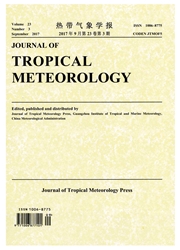

 中文摘要:
中文摘要:
Haze-to-fog transformation during a long lasting,low visibility episode was examined using the observations from a comprehensive field campaign conducted in Nanjing,China during 4-9 December 2013.In this episode,haze was transformed into fog and the fog lasted for dozens of hours.The impacts of meteorological factors such as wind,temperature(T) and relative humidity(RH) on haze,transition and fog during this episode were investigated.Results revealed significant differences between haze and fog days,due to their different formation mechanisms.Comparison was made for boundary-layer conditions during hazy days,haze-to-fog days and foggy days.Distributions of wind speed and wind direction as well as synoptic weather conditions around Nanjing had determinative impacts on the occurrences and characteristics of haze and fog.Weakened southerly wind in southern Nanjing resulted in high concentration of pollutants,and haze events occurred frequently during the study period.The wind speed was less than 1 m s-1 in the haze event,which resulted in a stable atmospheric condition and weak dispersion of the pollutants.The height of the temperature inversion was about 400 m during the period.The inversion intensity was weak and the temperature-difference was 4℃ km-1 or less in haze,while the inversion was stronger,and temperature-difference was about 6℃ km-1,approaching the inversion layer intensity in the fog event.Haze event is strongly influenced by ambient RH.RH values increased,which resulted in haze days evidently increased,suggesting that an increasing fraction of haze events be caused by hygroscopic growth of aerosols,rather than simply by high aerosol loading.When RH was above 90%,haze aerosols started to be transformed from haze to fog.This study calls for more efforts to control emissions to prevent haze events in the region.
 英文摘要:
英文摘要:
Haze-to-fog transformation during a long lasting, low visibility episode was examined using the observations from a comprehensive field campaign conducted in Nanjing, China during 4-9 December 2013. In this episode, haze was transformed into fog and the fog lasted for dozens of hours. The impacts of meteorological factors such as wind, temperature (T) and relative humidity (RH) on haze, transition and fog during this episode were investigated. Results revealed significant differences between haze and fog days, due to their different formation mechanisms. Comparison was made for boundary-layer conditions during hazy days, haze-to-fog days and foggy days. Distributions of wind speed and wind direction as well as synoptic weather conditions around Nanjing had determinative impacts on the occurrences and characteristics of haze and fog. Weakened southerly wind in southern Nanjing resulted in high concentration of pollutants, and haze events occurred frequently during the study period. The wind speed was less than 1 m s(-1) in the haze event, which resulted in a stable atmospheric condition and weak dispersion of the pollutants. The height of the temperature inversion was about 400 m during the period. The inversion intensity was weak and the temperature-difference was 4 degrees C km(-1) or less in haze, while the inversion was stronger, and temperature-difference was about 6 degrees C km(-1), approaching the inversion layer intensity in the fog event. Haze event is strongly influenced by ambient RH. RH values increased, which resulted in haze days evidently increased, suggesting that an increasing fraction of haze events be caused by hygroscopic growth of aerosols, rather than simply by high aerosol loading. When RH was above 90%, haze aerosols started to be transformed from haze to fog. This study calls for more efforts to control emissions to prevent haze events in the region.
 同期刊论文项目
同期刊论文项目
 同项目期刊论文
同项目期刊论文
 ANALYSIS OF THE MICROPHYSICAL STRUCTURE OF RADIATION FOG IN XUANEN MOUNTAINOUS REGION OF HUBEI,CHINA
ANALYSIS OF THE MICROPHYSICAL STRUCTURE OF RADIATION FOG IN XUANEN MOUNTAINOUS REGION OF HUBEI,CHINA 期刊信息
期刊信息
